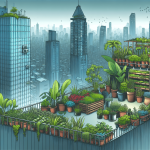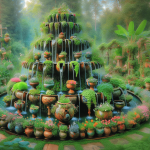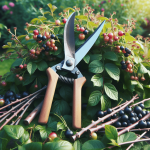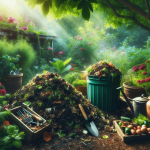This post may contain affiliate links. As an Amazon Associate, we may earn commissions from qualifying purchases.
Have you ever wondered how to successfully grow herbs in containers, even if you don’t have a sprawling garden? Container gardening provides an excellent opportunity to cultivate your favorite herbs, right from the convenience of your windowsill, balcony, or porch. But like all forms of gardening, it comes with its own set of challenges and best practices. This guide will walk you through those nitty-gritty details, helping you make the most out of your container garden.
Understanding Container Gardening
Container gardening is the practice of growing plants in various kinds of vessels rather than planting them in the ground. While it’s particularly popular for urban dwellers, it has its unique benefits for anyone interested in growing herbs.
Benefits of Container Gardening
One of the greatest advantages is that you can control the environment more easily. From the type of soil to the amount of water each herb receives, you have a lot more control than you would in a conventional garden. Containers are also excellent for avoiding pests and diseases that can easily spread in larger garden plots.
Potential Challenges
However, container gardening isn’t without its challenges. Plants can become root-bound, meaning their roots can outgrow the container. Pest control might be easier in some aspects, yet aphids and other nuisances can still make a home in your pots. So, it’s essential to understand both the benefits and challenges when you embark on your herb-growing journey.
Choosing the Right Containers
Selecting the right containers for your herbs is like choosing the perfect home. They should be aesthetically pleasing but, more importantly, functional.
Size and Material
The size of your container should match the herb you’re planting. For example, basil needs a pot that’s at least 8 inches deep, while thyme can thrive in a smaller, 6-inch pot. Materials range from plastic to terracotta to ceramic, each with its own pros and cons.
- Plastic: Lightweight and retains moisture but can overheat if exposed to direct sunlight for long periods.
- Terracotta: Breathable and good for preventing root rot but tends to dry out quickly.
- Ceramic: Durable and looks attractive but can be more expensive and heavy.
Table: Container Material Comparison
| Material | Pros | Cons |
|---|---|---|
| Plastic | Lightweight, retains moisture | Can overheat in direct sunlight |
| Terracotta | Breathable, prevents root rot | Dries out quickly |
| Ceramic | Durable, aesthetic | Expensive, heavy |
Drainage
Drainage is a crucial element. Your containers must have holes at the bottom to allow excess water to escape. Without proper drainage, waterlogged soil can lead to root rot and other problems.
Selecting the Best Herbs for Containers
Not all herbs are created equal, especially when it comes to container gardening. Some herbs naturally thrive in confined spaces, while others need room to spread out.
Easy-to-Grow Herbs
If you’re a beginner, consider starting with herbs that are more forgiving and easier to maintain. Here are a few:
- Basil: Perfect for warm, sunny spots, basil can grow quickly in containers.
- Mint: While mint can be invasive in a garden, containers can keep its spread in check. Just make sure to give it enough water.
- Chives: Easy to grow and versatile, chives do well in small spaces.
Herbs That Require More Attention
For those who like a bit more of a challenge, consider these options:
- Lavender: Needs well-draining soil and lots of sunlight.
- Rosemary: Requires careful watering practices, as it doesn’t like to be waterlogged.
- Cilantro: Tends to bolt quickly in heat, meaning it flowers and goes to seed, so it needs cool, consistent temperatures.
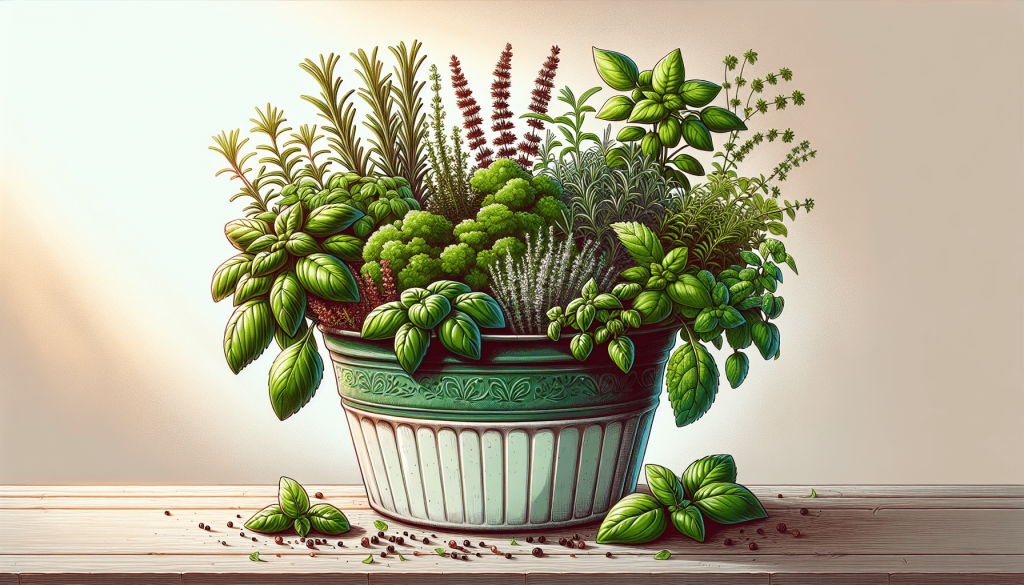
Potting Mix and Soil
The type of soil you use can make a significant difference in the health and growth of your herbs.
Ideal Potting Mix
Ideal potting mix generally consists of a combination of soil, compost, and perlite or vermiculite. The soil provides nutrients, the compost improves fertility, and perlite or vermiculite ensures proper drainage and aeration.
DIY Potting Mix Recipe
Here’s a simple recipe you can try at home:
- 2 parts good-quality potting soil: Acts as the base.
- 1 part compost: Adds nutrients.
- 1 part perlite or vermiculite: Improves drainage and aeration.
Soil pH and Fertility
Most herbs prefer slightly acidic to neutral soil (pH 6.0-7.0). It’s a good idea to test your soil’s pH and make adjustments if necessary. You can use lime to raise the pH or sulfur to lower it. Fertility is equally crucial; use an organic fertilizer once a month during the growing season to keep your herbs thriving.
Planting Your Herbs
Now that you’ve got your containers and soil ready, it’s time to get those herbs planted.
Planting Seeds vs. Plants
You have the option to start your herbs from seeds or purchase young plants from a nursery. Starting from seeds is cost-effective but requires more time and patience. Buying plants gives you a head start but can be a bit pricier.
- Seeds: Follow the instructions on the packet. Ensure that the soil remains moist but not waterlogged during germination.
- Transplants: When planting young herb plants, gently ease them out of their nursery pots, loosen the roots, and plant them in your prepared containers. Ensure that the surface level of the potting mix matches that of the nursery pot.
Plant Spacing
Spacing is critical. Don’t overcrowd your pots; it can lead to unhealthy competition for nutrients and water. Here’s a general guide:
- Basil: 1 plant per 8-inch pot.
- Mint: 1 plant per 12-inch pot.
- Chives: Several plants can share a 6-inch pot.
Watering Practices
Watering your container herbs needs special attention. Unlike garden plants, container-grown herbs rely entirely on you for moisture.
Frequency and Amount
Herbs generally prefer their soil to be consistently moist but not waterlogged. The frequency of watering will depend on factors such as the type of herb, pot size, and weather conditions.
- Daily check: During hot weather, you may need to water daily.
- Moisture level: Stick your finger 1 inch into the soil; if it feels dry, it’s time to water.
Avoid Overwatering
Overwatering is a common mistake. Ensure the water thoroughly moistens the soil but drains out the bottom. Empty any standing water that collects in the saucer.
Mulching
Consider adding a layer of mulch. It helps to retain soil moisture and prevent water from evaporating too quickly. Organic mulches like coconut coir or wood chips work well.
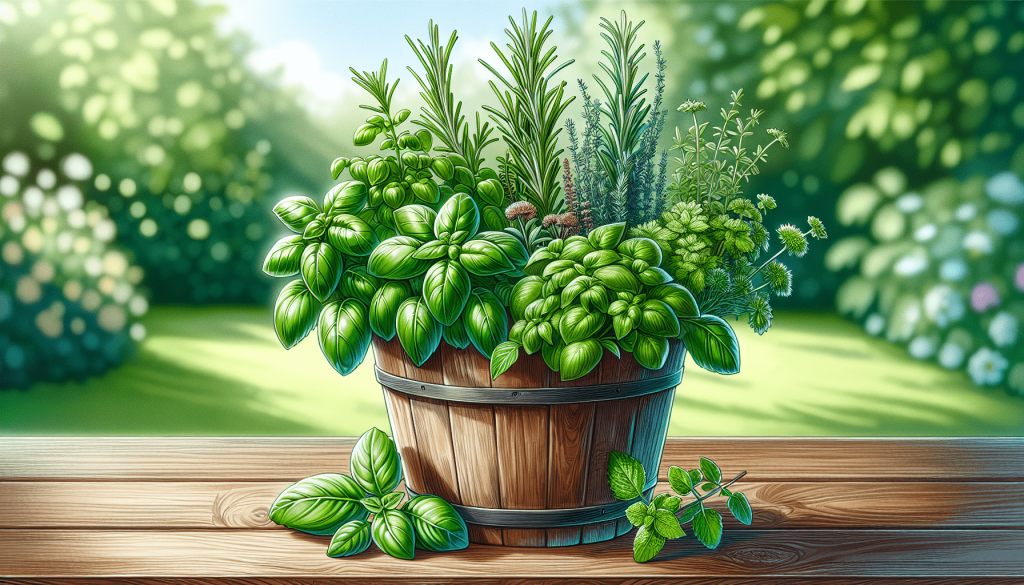
Sunlight Needs
Sunlight is food for your herbs, and giving them enough of it is key to their success.
Light Requirements
Most herbs require at least 6-8 hours of direct sunlight each day. However, some herbs like parsley and cilantro can tolerate partial shade.
- South-Facing Windows: Ideal for herbs that need full sun.
- East/West-Facing Windows: Good for herbs requiring moderate sunlight.
Indoor Light Solutions
If natural sunlight isn’t enough, you can supplement with artificial grow lights. LED grow lights are efficient and can provide the necessary light spectrum for your herbs.
Fertilizing Your Herbs
Fertilizing helps to replenish the nutrients in your soil, keeping your herbs healthy and productive.
Types of Fertilizers
Herbs benefit from balanced, organic fertilizers. Fish emulsion, worm castings, or diluted liquid seaweed are excellent options.
- Fish Emulsion: High in nitrogen but can have a strong odor.
- Worm Castings: Rich in nutrients and improve soil structure.
- Liquid Seaweed: Contains essential trace minerals and can help with stress resistance.
Application Frequency
- Monthly: Generally, a monthly feeding during the growing season should suffice.
- Diluted Solutions: Since container plants are more susceptible to fertilizer burn, always use diluted solutions.
Pruning and Harvesting
Pruning and harvesting are not only ways to keep your herbs producing but also opportunities to enjoy the fruits of your labor.
Pruning
Regular pruning encourages lush growth and prevents herbs from becoming leggy. Remove any yellowing or dead leaves to keep the plant healthy.
- Cilantro: Pinch off flowers to prevent it from bolting.
- Basil: Trim above a pair of leaves, ensuring you leave enough foliage for photosynthesis.
Harvesting
The best time to harvest herbs is in the morning after the dew has dried but before the heat of the day.
- Mint: Harvest leaves by pinching off stems just above a leaf node.
- Rosemary: Snip sprigs at the desired length, being careful not to take more than one-third of the plant.
Overwintering Your Herbs
Some herbs can be grown year-round if given the right conditions. Overwintering requires specific strategies to keep your plants alive through colder months.
Indoor Transition
Move your herbs indoors before the first frost. Place them in a south-facing window and reduce watering and fertilizing as the plant’s growth slows down.
Outdoor Strategies
If you prefer to leave your pots outside, protect your herbs by wrapping the containers in bubble wrap or moving them to a sheltered location. Some hardy herbs like thyme and oregano can survive a mild winter outdoors.
Common Pests and Diseases
Even in containers, your herbs aren’t immune to pests and diseases. Regular inspection and prompt action can keep problems at bay.
Common Pests
- Aphids: These tiny insects suck sap from your herbs. You can remove them with a strong spray of water or introduce natural predators like ladybugs.
- Spider Mites: Look for tiny webs on the undersides of leaves. Neem oil or insecticidal soap can help manage infestations.
Common Diseases
- Powdery Mildew: This fungal disease appears as white powder on leaves. It thrives in humid environments, so ensure good air circulation.
- Root Rot: Prevent by ensuring proper drainage and not overwatering.
Organic Solutions
- Neem Oil: Effective against a wide range of insects and fungi.
- Insecticidal Soap: Good for controlling soft-bodied insects like aphids and whiteflies.
- Garlic Spray: Acts as a natural insect repellent.
Seasonal Care
Different seasons call for different care routines for your container herbs.
Spring and Summer
This is the peak growing season. Focus on regular watering, feeding, and pinching back herbs to encourage bushy growth.
- Basil: Thrives in warm weather and requires frequent harvesting to prevent flowering.
- Parsley: Prefers cooler temperatures and continuous harvesting.
Fall and Winter
Adjust your care routine as the days shorten and temperatures drop.
- Reduce Watering: Most herbs will require less frequent watering during cooler months.
- Light Supplementation: Use grow lights if natural light levels are insufficient.
Combining Herbs in Containers
You can mix different herbs in a single container, provided they have similar growing requirements.
Compatible Herbs
- Basil and Parsley: Both prefer more water and similar sunlight conditions.
- Rosemary and Thyme: Suit dry conditions and share sunlight needs.
Arrangement Tips
Plant the taller herbs in the center or back of the container, with lower-growing herbs around the edges. This not only looks attractive but also ensures each herb gets enough light.
Troubleshooting Common Issues
When growing herbs in containers, you might encounter some problems. Knowing how to diagnose and address them can save your plants.
Yellowing Leaves
- Cause: Usually a sign of overwatering, nutrient deficiency, or poor drainage.
- Solution: Check the soil moisture, improve drainage, and consider feeding the plant.
Wilting
- Cause: Can result from underwatering, root-bound conditions, or excessive heat.
- Solution: Adjust watering schedule, repot if necessary, or move the container to a shadier spot.
Poor Growth
- Cause: Often due to lack of sunlight or poor soil quality.
- Solution: Ensure the herb is getting at least 6-8 hours of sunlight and refresh the soil as needed.
Conclusion
Growing herbs in containers can be a rewarding experience, whether you’re new to gardening or a seasoned green thumb. By following these best practices, you can enjoy fresh, homegrown herbs year-round. Not only will you have a bountiful supply of culinary delights, but you’ll also benefit from the joys and therapeutic effects of tending to your garden. Now, who would’ve thought that a few pots on a windowsill or balcony could bring so much satisfaction?

